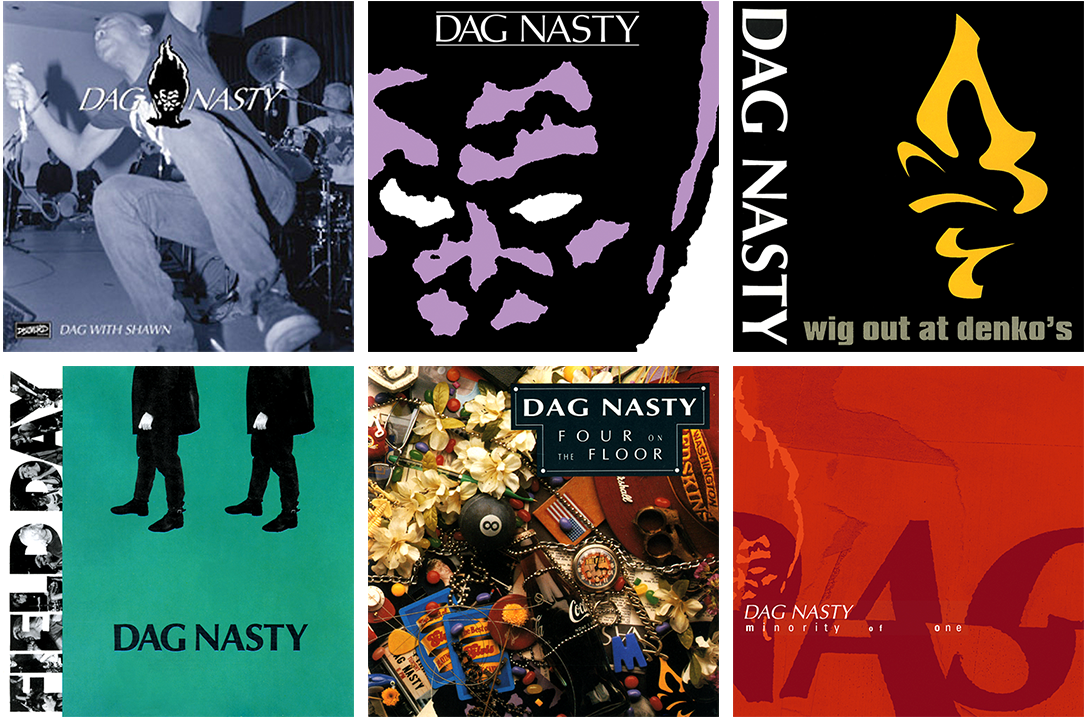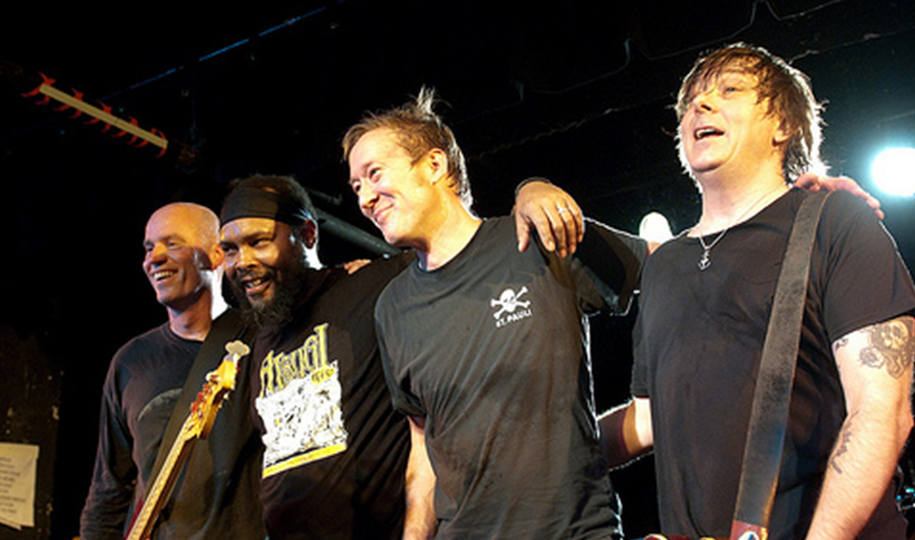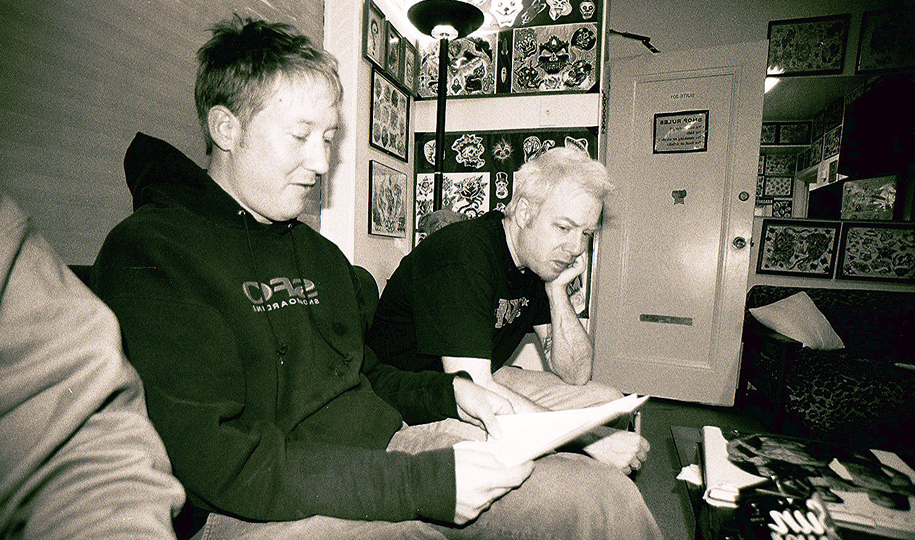
The band started in the summer of 1985, made up of ex-members of Minor Threat and Bloody Mannequin Orchestra. Through the years, they cycled through 3 different singers, 2 bass players, and 3 drummers in their four year active existence (1985-1988). The band itself had a huge impact on the world of underground music, due to the fact that Dag Nasty practically introduced melodic hardcore in the mid-'80s. But although the group was more accessible and melodic than Minor Threat or similar bands, they never lost their bracing, blistering edge. The concept of the band came about from former-Minor Threat and Meatmen guitarist Brian Baker. After vocalist Shawn Brown departed the group, ex-DYS frontman Dave Smalley completed Brian Baker's vision of what the band should be.
Dag Nasty recorded their first album, "Can I Say" (1986), with D.C.-punk guru Ian MacKaye assisting on the production. The following year, Smalley left the group; he was replaced by Peter Cortner, who added more pop elements to the band's sound with the album "Wig Out at Denko's". Dag Nasty moved from MacKaye's Dischord label to Giant in 1988 and released their last album (at the time), "Field Day". This album was even more of a departure from the original sound.
After the break up of the band, the members of the band went their seperate ways and were involved in various projects of their own. Along with former-Big Boy Chris Gates, Baker formed the metal band Junkyard in 1989, which released two records on Geffen before fading away.
Dag Nasty came back together in 1992 with Dave Smalley back on vocals. They released "Four on the Floor" for the growing underground punk scene that was only a few short years from breaking into the mainstream. The response was enthusiastic, but the band stepped away from the business again. Ten years later, they reunited once again with "Minority of One" which was released on Revelation Records. But from that point on, the band members have each been focusing on their full-time bands...or jobs...whichever the case may be.
There was a blip on the Dag Nasty radar though, back in 2012, when the band reunited for a one-off show in DC in support of the "Salad Days" documentary, this time with original vocalist Shawn Brown on vocals. Then, in 2016, that same line-up announced the release of a brand new 7-inch and a full-blown tour, again with Shawn Brown behind the mic. Whether this is just another temporary reunion, or something a bit more permanent, remains to be seen.
A comprehensive list of everything that has been released by Dag Nasty, along with lyrics and downloads to many of their tracks.
View Discography →
Over the years, Dag Nasty has graced many venues with their presence. Here's a listing of all their gigs, along with some vids. Disclaimer: This page is way outdated. We're working on it...
See Shows→
Let's go back to 2002, when Dag Nasty came out of hiatus for a bit to record a new record. Here's a day-by-day account of what went into the making of "Minority of One".
Read the Diary →
01. What does Dag Nasty mean?
02. Where did the flaming head logo come from?
03. What is the song "Justification" about?
04. What does the symbol on the cover of "Wig Out at Denko's" mean?
05. What, and where, is "Denko's"?
06. Who are the people mentioned in the song "Wig out at Denko's"?
07. What is the song "Crucial Three" about?
08. Who is the song "Matt" about?
09. Is Mrs. Touma a real person? Is the song a true story?
10. Who are Los Vampiros?
01. What does Dag Nasty mean?
Dag Nasty is a slang exclamation, usually meaning awful (e.g. "What is that Dag Nasty smell"), but it can be used in a positive sense (e.g. "This pizza is Dag Nasty"). It was also a children's board game in Germany.
02. Where did the flaming head logo come from?
The flaming head logo used for the cover of "Can I Say" came from an idea seen in an American movie from the 1930's. Apparently, at the end of this movie, the main character's hair catches on fire due to all of the pain and anger that was built up inside of him. I, nor any members of the band, know the title of the movie.
03. What is the song "Justification" about?
Justification was written about another band from Washington, Marginal Man. Dag Nasty sent their demo tape to them because they had interest in playing shows together. The members of Marginal Man weren't very psyched.
04. What does the symbol on the cover of "Wig Out at Denko's" mean?
The Symbol translates as "Al Hamdu lillah" or, "Praise Be to God" in English.
Peter Cortner explains how he came across the symbol..."Back when my wife and I lived in D.C., we had a Persian prayer rug decorated with Arabic script (I'm not sure whether the actual language was Arabic or Farsi). One day I noticed a character or series of characters that reminded me of DN's burning head logo. I traced it directly onto a piece of onion-skin paper and drew a little mock-up of an album cover around it using some rub-on letters to spell out the band name and title. I showed it to the rest of the band, and they approved it. I gave the sheet of onion skin to the folks at Dischord. They reproduced it almost exactly, even using the same font I'd used on the mock-up. I hadn't actually intended to use that font - I wanted to use the same font they'd used on Can I Say - but I never bothered to say that to anyone at Dischord. Now, however, I really love that cover, font and all".
05. What, and where, is "Denko's"?
Denko was a guy from Washington who used to throw house parties. Peter's friend Hal used to drag him along to the parties. Strangely, none of the other members of Dag Nasty ever attended these parties.
06. Who are the people mentioned in the song "Wig out at Denko's"?
Dag Nasty mention several people in that song, Mark, Hal and Yanni. Mark and Yanni were in a band with Peter called Protem, and they were the one's who encouraged Peter to try out for Dag Nasty. Mark also played drums for Beefeater, and Yanni played in Stinking Lizaveta. Hal was a friend of Peter's from high school, and he sang for Body Count (NOT Ice-T's band). Body Count were around from 1982 to 1984, and have one song on the "Bouncing Babies" compilation on Fountain of Youth Records. Not mentioned in the song was the vocalist for Protem, Damon Locks, who was also in Trenchmouth and went on to sing for The Eternals.
07. What is the song "Crucial Three" about?
Crucial Three refers to the members of a bizarre love triangle. The song is about how one's present day emotional health can be adversely affected by events in the past, even if the events are forgotten or repressed.
08. Who is the song "Matt" about?
Peter Cortner wrote "Matt" about Scott Garrett's younger brother.
09. Is Mrs. Touma a real person and is the song a true story?
Yes.
10. Who were Los Vampiros?
Los Vampiros was a side project of some of the members of Dag Nasty. They released a 7" EP and a full length LP on Selfless Records. When Brian was in California recording the Doggy Style LP In 1986, Peter, Colin and Roger got together with Don Zinzel (Troubled Gardens) and recorded a few songs. Selfless released this seven inch by Los Vampiros in 1991 which features the songs they recorded in 1986. They re-formed in 1990 with Mike Davis from Foundation playing guitar, and Eban Burr playing bass and recorded an LP for Selfless Records called "Less Than A Feeling". This record was released on LP and CD in 1991, but is quite difficult to find. Some of the records came with an additional 12" record which features outtakes from 1986, and a telephone interview with Peter Cortner. If you can find either one of these records, pick it up. It is seriously amazing stuff. They are available on black and clear red vinyl. Los Vampiros also appeared on a compilation in the early 90's, contributing one track, "I Kill Dogs".